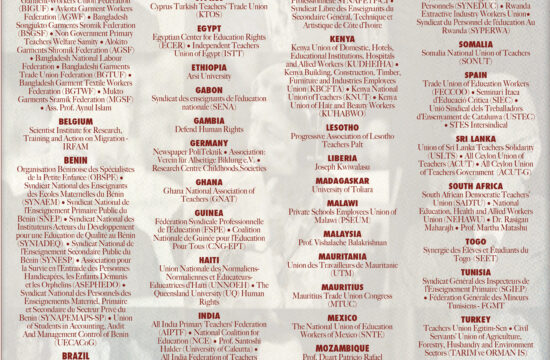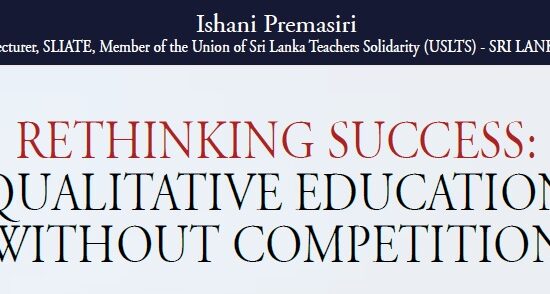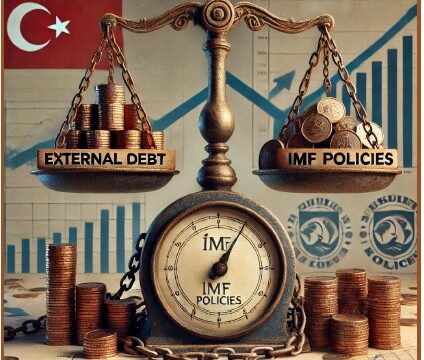Dr. Halit Suiçmez
Economist-Writer – TÜRKİYE
picture: Wikimedia Commons: Atatürk sanayideki gelişimi denetlerken.jpg
CONTENTS;
1- What is Political Economy?
2- A Century of Political Economy (general outlines)
3- Growth-Development Challenges and Productivity
4- References
1- What is Political Economy?
There is constant movement in social life, as in nature. Science is the attempt to find the laws of these motions (movements).
We leave movements in nature to the scientists and try to understand social changes.
Countless economic, political, social and cultural events and phenomena have taken place and are still taking place in the history of societies.
Human beings are the subject of social movement.
Human beings behave within certain modes and relations of production, which can change according to periods.
Different relations of production and patterns of behavior exist in the primitive, slavery, feudal and capitalist modes of production.
A clear method and approach is needed to understand the dynamics shaping social processes, even if there are differences.
Such an approach is a political economy philosophy, an idea.
The times, the places, the ways in which the resulting “surplus values” are obtained may change, but the essence of the distribution and the relations of exploitation do not change much.
The times, the places, the ways in which the resulting “surplus values” are obtained may change, but the essence of the distribution and the relations of exploitation do not change much.
Therefore, we should be guided by whichever method is based on the sharing of the surplus value generated at the end of the production process.
In this context, this most scientific method of history and society is the “revolutionary political economy” approach.
Political Economy Approach
The first name given to the Science of Economics was “Political Economy, or Politics of Economy”. (Prof. Dr. Vural Fuat Savaş, Political Economy, 6th Edition, Beta Basım, October 2008, Istanbul, p;7
Classical economists used the term “Politics of Economy” for a long time. Universities have established departments under this name.
In 1805, Malthus was called “Professor of Modern History and Politics of Economy”. Oxford and London universities had departments of political economy in 1820. (ibid. p; 7)
The economics lectured in these departments was undoubtedly “bourgeois political economy”.
In 1859 Karl Marx published a book titled “A Contribution to the Critique of Political Economy”.
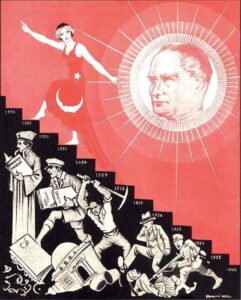 Wikimedia Commons: Classroom_19th_century_English_School.jpg
Wikimedia Commons: Classroom_19th_century_English_School.jpg
In this work, he criticized classical economics, that is, the Political Economy of his time. Marx created a different kind of economics.
In the economics of Marx, the concepts, theories and analytical methods are different.
In 1890, A. Marshall wrote a book and published it under the title “Principles of Economics”.
Since that time, liberal economists have not used the name “Political Economy”. They use the term economic policy.
However, there can be no such thing as economic policy on its own. Every economic policy is determined within a political structure, and politics and economics are closely intertwined.
Two types of political economy exist: Bourgeois political economy is committed to metaphysical thinking and advocates capitalism.
Revolutionary political economy, on the other hand, is the science that studies the social structure of production. It examines the social relations of production and distribution. They analyze this within the historical developments of these processes.
Revolutionary political economy studies the specific laws of production and distribution and deduces from them the general laws of production and distribution.
Since bourgeois political economy is based on metaphysics, it is unscientific. Revolutionary (dialectical) political economy, however, is scientific.
Bourgeois political economy is non-scientific in the sense that it analyzes individual economic activities and attributes them to infinitely immutable laws that are always and everywhere valid.
Revolutionary political economy approaches every economic process with the question “who won and who lost”.
As society is composed of classes, every economic practice results in an increase in income and welfare for some strata, while other strata experience either a loss of welfare or “stagnation”.
After all, the revolutionary political economy model teaches us this;
Economy is a condensed form of politics.
Unless the political structure as a whole is in the hands of the popular classes and strata, economic policy cannot be implemented in the interest of the people.
As in everything else, any process, any phenomenon in the economy is political.
Therefore, broadening the base of a populist policy is the wisest way forward.
These facts lead us to the conclusion that if an economic event, phenomenon or process is being discussed somewhere, we should immediately ask, “which economics?”
In other words, which economics the issue falls under.
Because there is bourgeois economics, also called bourgeois political economy, and then there is the real economy, the economy of the people, that is, revolutionary political economy.
Bourgeois economics serves as a veil to hide the facts, it distorts concepts, it has no human being at its core.
People’s economics, on the other hand, focuses on the real life struggles of millions of people, starting from the very bottom of society, and presents human beings, society, the production process, the relations of production and social relations in all their manifestly real dynamics.
This economics, in other words revolutionary political economy, is capable of making the best contribution to the struggle to understand and explain social life with its historical and social dynamics and to give political power to the working class, the real owners of it. (Dr. Halit Suiçmez, Intellectual Writings in the Cycle of Literature and Economics, İzan Publishing, Ankara, 2022, Essay, p.14)
2- A Century of Political Economy (general outlines)
The period between 1908, when the Second Constitutional Monarchy began, and 1922, when the War of Independence ended, can be considered as the years of war and revolution.
The period between 1923 and 1929 can be described as a period of re-establishment under the conditions of open economy in Türkiye.
The period between 1929-30, when the great depression of the world began, and 1939, when the second imperialist war began, was dominated by a statist-protective industrialization line in Türkiye.
It would be convenient to refer to the period between 1940 and 45, when the Second World War began and intensified, as a period of interruption in terms of economic developments.
The period from 1946, when the war ended, to 1953, the first period of the Menderes government, may be interpreted as a different period of articulation with the world economy.
The period between 1954-61 can be considered as a period of stagnation and readjustment in terms of capital accumulation and some economic developments.
It is possible to evaluate the 1960-80 period as two intermediate periods.
In the years 1962-76, there was an inward-oriented and foreign-dependent expansion.
In 1977-79, there was a new depression.
From a political economy perspective, in 1980-88 there was an “offensive” of capital against the working class and the people in general.
In the period between the years l989 -1997, when liberalization gained momentum, there was a complete capitulation to finance capital and a return to populism in the dominant sectors.
Between the years 1998-2002, various crises took place again with constant IMF supervision.
The first period of the AKP ruling, 2003-2007, when global capital was abundant and flowed into Türkiye with high profits, is considered in the literature as the “Tulip Era”.
The subsequent period of 2008- 2015 and the period after 2016, when the distribution worsened, represent very important turning points both politically and economically.
3- Growth-Development Challenges and Productivity
A sustainable development is based on productivity and employment-oriented growth.
In developed countries, the share of technology and total factor productivity in growth is higher than in developing countries.
In Türkiye, the share of productivity in growth has been low for many years, and has partially increased recently
A comprehensive growth and productivity planning is imperative in the period to come, both to raise the growth rate and to increase the share of productivity based on technological increase in growth.
What is the Challenge for Growth in Türkiye?
The growth issue is much debated in terms of quality and permanence
Let us look at how the problem is perceived in political, academic and industrial circles; First of all, let’s reveal the way in which the problems of growth are defined at the political level:
The views of Babacan, former Minister of State and Deputy Prime Minister in charge of the economy, on this issue are very important. The following quote shows his approach to this issue.
“Not only the quantitative growth rate of a country, but also the nature of growth is an important factor that everyone should pay attention to in the period ahead…
“When we analyze the nature of growth, is it coming from the public sector or is it coming from the private sector? Is growth coming from consumption or investment? Is it growth based on domestic savings or on external resources? Where does the debt stock of the public sector and the debt of companies go as a result of growth?
First of all, a growth that depends not on consumption, but on investments by the private sector and the public sector… A growth structure where the private sector, not the public sector, dominates investment and spending…
Babacan stressed that growth based not only on domestic demand but also on foreign demand and exports is a very important factor and added: “Türkiye will only have healthy growth in the real sense as long as it produces, as long as it produces with high added value, and as long as it sells more of its products and services to the international market.”
“…we should not burden future generations with the debt of growth.” (Hürriyet, 19.09.2013)
This quote indicates that economic growth should be analyzed in terms of its nature, and by this we understand the importance of the concept of growth through production
Prof. Dr. Erinç Yeldan, one of the academics who has published most articles and conducted research on growth and development in Türkiye, also focuses a lot on the nature of growth.
According to the author; (Source; No Change in the Structure of Growth, April 02, 2014 Cumhuriyet) it is very important to reveal the sources of growth.
“National income statistics were published without much fanfare earlier this week.
According to the estimates of TÜİK (Turkish Statistical Institute), the Turkish economy grew by 4 percent in 2013.
Evaluations on the sources of growth show that the national economy grew mainly on private consumption expenditures and public investments.
The contribution of private fixed capital investments to growth is almost zero, while the main item of public investments comes from public construction.
Exports do not contribute to growth either, suggesting that the economy is growing based on domestic (consumption) demand.
Growth being increasingly dependent on current account deficits is the national economy’s biggest dilemma and its main point of vulnerability.
The growth structure of 2013 indicates that the problem of “moderate growth based on external resources” is getting more and more severe.
We might compare the sources of growth in the Turkish economy in 2013 with those observed since the global crisis. In Table 1 we present one such study.
Table 1: Sources of Growth: Sources of Growth
2008-2013 (With 1998 Prices)
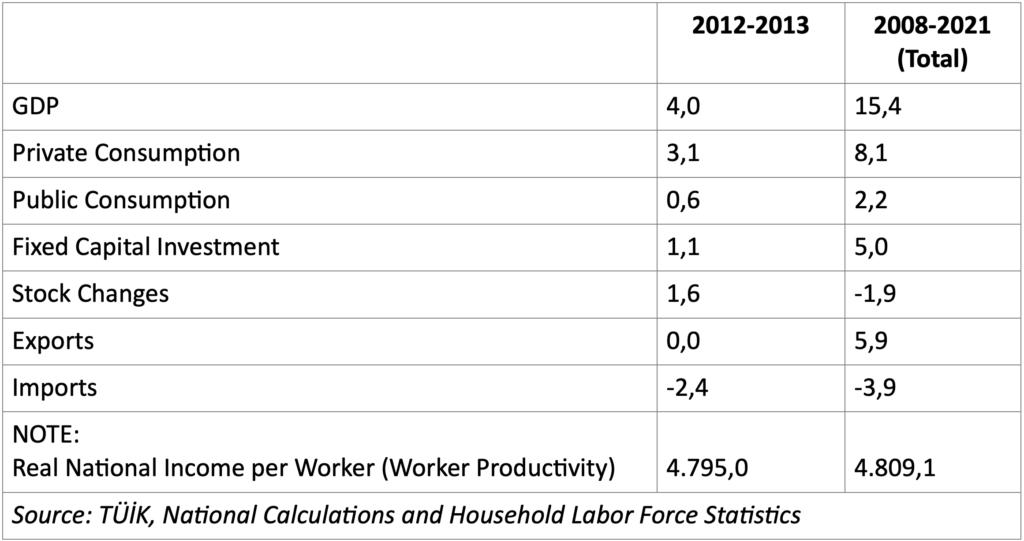
Between 2008 and 2012, including the period before and after the crisis, Türkiye achieved a cumulative growth rate of 15.4 percent. Almost two thirds of this was based on “consumption” expenditures; 8.1 percent private and 2.2 percent public. The contribution of investments was around 5 percent,
while the contribution of net exports (exports minus imports) was small but positive.
2013 was characterized by cyclical growth based on domestic consumption and stock accumulation, where investment and export contributions were no longer relevant.
Table 2: National Income Flexibility of Employment (Annual Averages)

The problem of the economy’s dependence on foreign resource inflows is most dramatically reflected in the loss of “productivity”. With a very rough but straightforward calculation, if we compare the productivity of workers in Türkiye in 2008 and 2013, we can see that the real national income generated per worker in 2008 was 4.809 TL (in constant prices of 1998) and that this figure declined to 4.795 TL in 2013.
An economy growing on the basis of borrowing-based consumption expenditure…
Growth in Türkiye has ceased to be about technological development and a productivity gain based on an educated labor force, and has been reduced to a game based on what the price of the dollar would be in international markets. (Erinç Yeldan, Middle Income Trap Issue, April 6, 2014 Cumhuriyet)
Employment flexibility, the data for which are presented in Table 2, also is an important tool for understanding the nature of growth. The employment flexibility shows how many units of employment are created for each unit of national income increase (percentage of employment/percentage of national income=0.25/1.00=0.25). This rate dropped to 0.14 percent after 2002. This means growth that does not create jobs.
In this quote, we again see that growth is based on consumption. Technological development and a skilled workforce are emphasized as the necessary sources of robust growth.
Let us now summarize the approach of an important representative from the business world;
One of the leading authorities of the business world, Ersin Özince, also supported this tendency by saying “we are a rentier economy”. The President of the İş Bankası has made a very interesting observation:
“Türkiye today consumes, not saves. We know this from our customers. Our customers who use credit are no longer investing. Most of them became market traders, real estate agents, builders. If you look at how much real estate prices have risen, you can see that Türkiye does not produce,“ he added, pointing out that the country’s economy would not be able to show the expected strength against bigger fluctuations.”(July 2, 2012, Dünya)
In our country, GDP is found to have increased at an average annual rate of 4.6 percent in 1998-2022, of which 2.9 percent is attributable to the increase in capital stock, 1 percent to the increase in total factor productivity and 0.7 percent to employment. (Nazlı S. Bölükbaşı, Research of the Ministry of Industry, 2023, p.11)
We can argue that in politics, academia and the business world there is a “common” approach to growth.
There is a common view across all social segments that the nature of economic growth is weak.
After these determinations about growth, let us now focus on what the challenge is in our country in terms of development:
What is the Challenge for Development in Türkiye?
Development is of course different from growth. It is the reflection of the increased production (growth) on the society in general in a more fair and balanced way and supported by social indicators. This phenomenon is mostly measured by human development indexes.
Türkiye ranks 92nd among 180 countries in human development. Also ranks 88th among 167 countries in the democracy index. It is in the “middle” in both indicators. Its development level and democracy report card are at close points. (Source: 1-http://www.izafet.com/genelkultur/ 608475-dunya-demokrasiindeksi- ulkelere-gore-demokrasisiralamasi. html#ixzz1wEpj2dBY, 2-UNDP, Human Development Report, 2009)
Our country generally presents the image of an intermediate „society of freedom and development“.
It is also worth investigating why Türkiye, which is among the top 20 countries in national income, ranks 59th in global competitiveness, 100th in basic education, 94th in education quality, 67th in innovation and 52nd in global information technology. (Source; OECD, 2011)
Nowadays, the concept of human development, founded on some of A. Sen’s notions, occupies a central role as the ultimate goal of development.
Human development includes many dimensions and perspectives, such as health, education, nutrition, housing, access to information, participation, regime type (democracy and degree of freedom). (Source; E.Thorbecke, Evolution of Development Doctrine, 1950-2005, Fikret Şenses, Neoliberal Globalization and Development, 2009, p; 166)
In another study about development, the following is said. ”… today we are the 17th country in the world in terms of production. But in terms of human development, we rank 84th out of 169 countries”. (Source; Sırma Demir Şeker, Analysis of Türkiye’s Human Development Index and Index Ranking Republic of Türkiye Ministry of Development, p;17, October 2011)
Türkiye has shown significant performance in terms of growth rate and national income, but why has failed to make a leap forward in terms of development?
This situation is closely related to our country’s distancing from the real economy.
Today, it is clear where we stand in human development, which is the real indicator of development. So the task is to identify the areas where we are weak. These are education, health, women’s employment, urbanization and democracy. But beyond that, the real problem is inefficiency.
We must become a Productivity Economy. We should use our human potential in the most accurate way in every field.
We should explore and find ways and methods to fully and effectively utilize our physical resources and all kinds of potentials, especially our human assets.
As a result, two concepts are needed for a real, fair and balanced development:
1-planning
2-efficiency
Productivity increases (increase in surplus value, technological development) have played a major role in the growth and development of industrialized countries.
This has been confirmed both historically and socially and currently.
It is also technically proven. In growth accounting, the share of TFP in growth plays an important role.
The 10th Development Plan emphasizes the connection between development and productivity. These connections are evaluated in the following sections of this paper.
After the challenges of growth and development, we can now address our weaknesses in the area of productivity, which is included in the scope of these two fundamental areas of economics.
What are the Challenges in
terms of Productivity in Türkiye?
There have been three productivity spurts in our country. However, these have not been permanent and sustainable. The first productivity spurt lasted from the mid-1960s to the mid-1970s. The source of productivity gains consisted of cheap industrial inputs provided by SOEs and rents generated by import protection walls.
The second productivity spurt came after 1980. The source of this was rents based on structural adjustment loans and export incentives.
The third productivity spurt took place in the 2002-2008 period after the 2001 crisis. The source of this was the 30 billion dollar loan from the IMF and hot money flows based on cheap foreign currency originating from the US in the global economy.
Türkiye has experienced this fatigue three times in the last 50 years. Because each time, the main source behind the productivity drive was based on rents, borrowing and cheap foreign currency resources.
The financing of the productivity drive was done with these unreliable resources, which were quickly exhausted.
Productivity gains must be backed by a financing based on national savings, R&D and technological development, and a qualified labor force.
Following these statements, we can list the problems that are being experienced in terms of productivity in our country;
1- The first problem is the inadequacy of the nature of the labor force and technological development.
2- Second problem is the significant stagnation of the productivity breakthrough after 2010.
3- There is a significant productivity gap between us and the world countries. This is also a very important problem that needs to be emphasized.
4- We can claim that the relations between productivity and macroeconomic variables are disconnected. MPM and VGM studies have made these determinations.
5- We should also mention that our productivity culture at the social level is very weak.
It is known that we waste many of our resources, especially our human assets.
The following tables (Tables 3-4) and figures (Figure 1) show the data on the problems listed above. For example, we see in Table 3 and Figure 1 that labor productivity became stationary between 2010-2013. The Productivity Comparison Table (Table 4) shows that Türkiye’s labor productivity index is 44 percent of that of the US.
Table 3: Quarterly Productivity Statistics
Production Index per Worker (2010 Average =100)
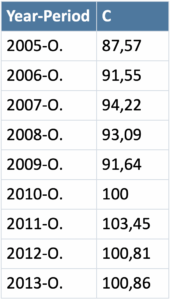 Source: http://vi.sanayi.gov.tr/rpr.aspx, access date; 08.05.2014
Source: http://vi.sanayi.gov.tr/rpr.aspx, access date; 08.05.2014
Table 4: US, OECD, Türkiye Productivity Comparison, 2009
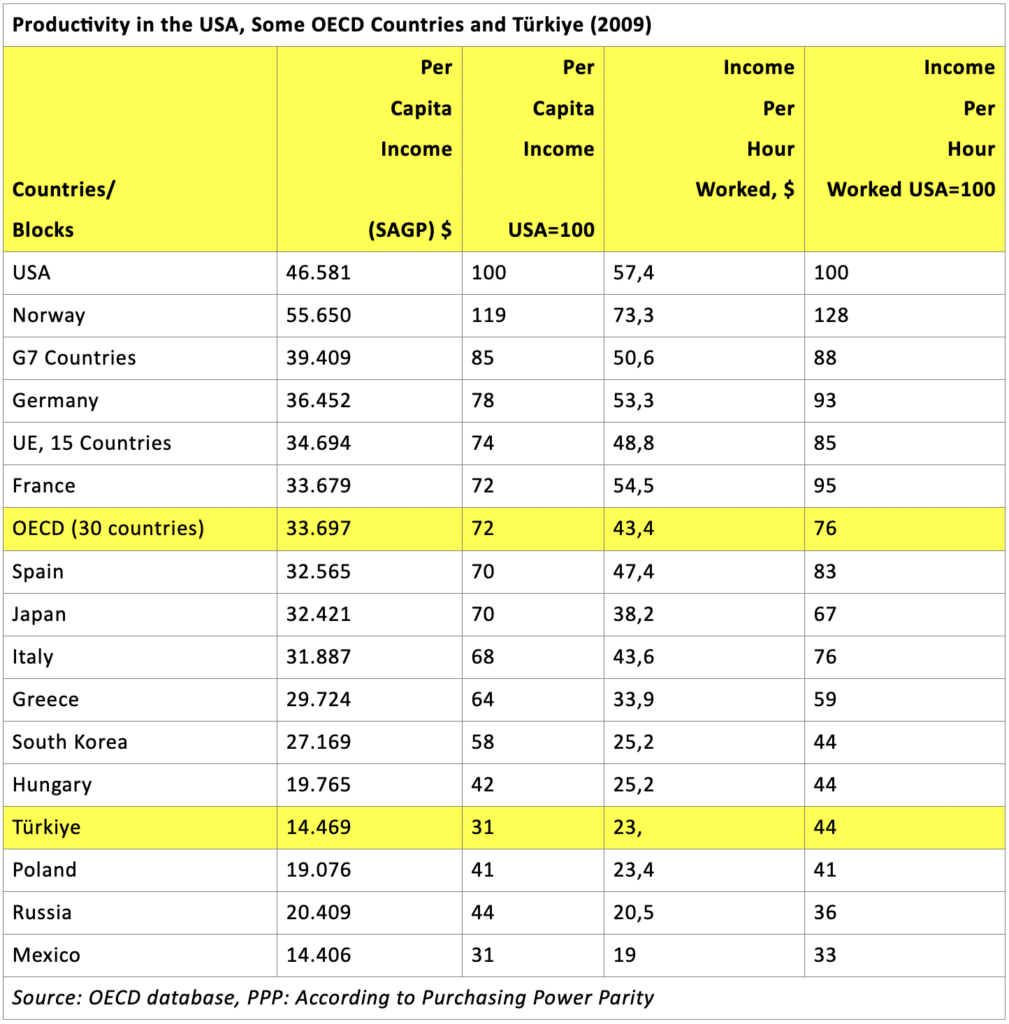
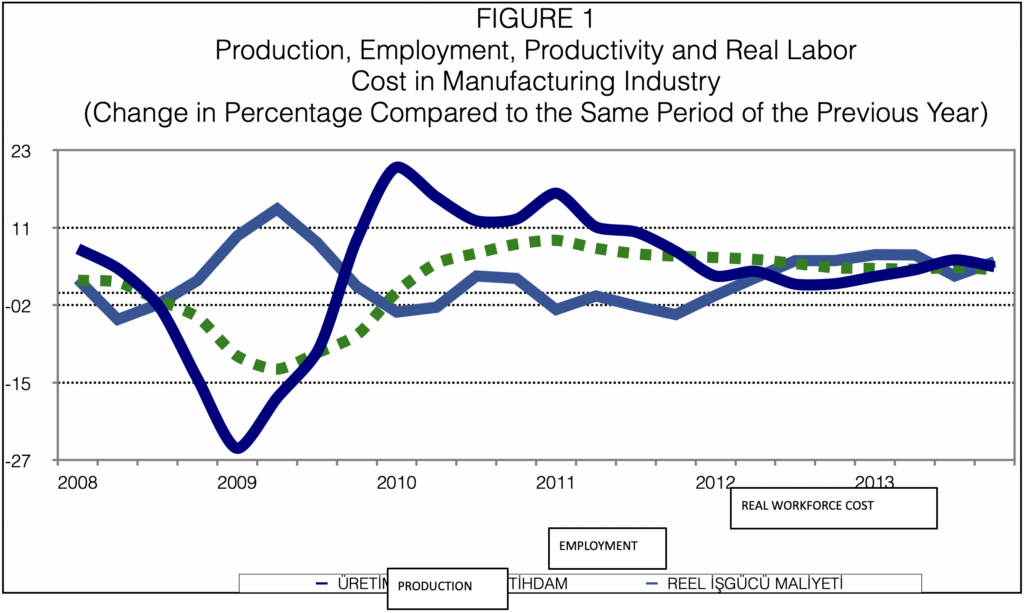
Source: TÜİK Short-Term Business Statistics, Production, Employment and Producer Price Index News Bulletins; conversion of monthly production index to quarterly, productivity and real labor cost calculation by TİSK, 2014
Following the discussion of the major challenges faced in our country in terms of growth-development-efficiency, it would be particularly useful to touch upon the growth-productivity relation.
What is the Challenge for Productivity-Growth Relation in Türkiye?
In the field of economics, there are studies called growth accounting that investigate the share of factors in growth.
The results of one of these are given below.
Between 1992 and 2000, the contribution of Total Factor Productivity (TFP) to growth was 50 percent in Belgium, 65 percent in Denmark, 93 percent in Finland, 85 percent in France, 65 percent in Germany, 51 percent in Italy, 100 percent in Sweden and -2.1 percent in Türkiye.
This rate was 6.5 percent in Türkiye between 1972-2000. (Source; Dr. Halit Suiçmez, The Role of TFP in Economic Growth, MPM Publication, 698, Ankara, 2008, p:13)
Between 1985-2012, the contribution of productivity to growth was 11.1 percent. The contribution of capital is 63.6 percent; the contribution of employment is 25.3 percent.
Growth should be more balanced in terms of the contribution of factors of production.
A study conducted by TUSIAD (TURKISH INDUSTRIALISTS‘ AND BUSINESSMEN’S ASSOCIATION) and TCMB (CENTRAL BANK OF THE REPUBLIC OF TÜRKİYE) in 2008 investigated the contribution of total productivity increase to growth in some OECD countries. According to this;
Table: Contribution of Productivity Factor to Growth in Some OECD Countries
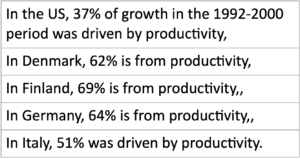
During this period (1992-2000), the share of productivity in growth in Türkiye was only 6%. (TÜSİAD, TCMB; 2008)
Another study analyzes the sources of growth in Türkiye. The sources of growth are given below. It is estimated that 14.1 percent of growth between 2002-2010 was driven by total factor productivity.
Table: Sources of Growth
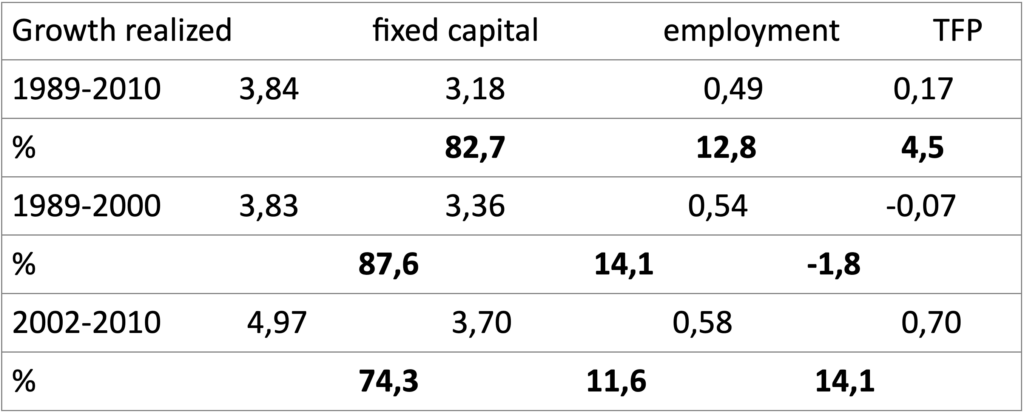
Source: Şeref Saygılı, Transformation in International Production Chains and Türkiye’s Position, Evaluation, March 2, 2012,TCMB
In another joint study conducted recently, the sources of growth over the last 30 years have been analyzed separately.
In the 2000s, while the contribution of Total Factor Productivity to growth continued to be around 20%, the contribution of labor was halved.
Due to both the decline in wages and the stagnation in labor force, the total contribution of labor is estimated to have declined to 13%.
The process, which is characterized by the substitution of the capital factor for the labor factor, is the main outcome of the process of non-employment- friendly growth and import-dependent industrialization.
The relevant data are presented in the Table below:
Table: Separate Analysis of the Growth Resources in the Turkish Economy After 1980
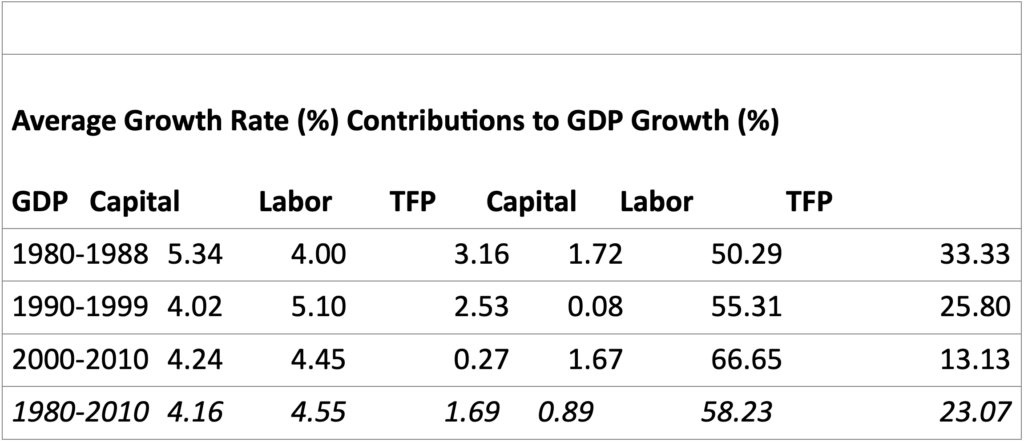
Source: Yeldan, A. Erinç Yeldan, A and Güneş Kolsuz (2014) “Separate Analysis of the Growth Resources in the Turkish Economy After 1980” Work and Society, 40(1): 49-66.
If Türkiye wants to become a member of the EU, if the country wants to achieve a respectable position among Western countries, it must formulate and implement policies that will base its growth on productivity gains at a higher rate.
If Türkiye aims to become one of the world’s top 10 economies having the world’s largest GDP, it needs to increase its Total Factor Productivity performance, which is one of the important sources of economic growth.
For this purpose, the contribution of knowledge capital and technological advances to Total Factor Productivity should be taken into account.
(Source: The Conference Board, Quoted by; Metin Ercan, Radikal, 05.04.2014)
Finally, let us consider how these relations are approached in the Tenth Development Plan:
What are the Predictions and Targets in Türkiye’s 10th Development Plan in terms of Productivity-Growth Relationship?
When the 10th Development Plan is analyzed as a whole, it undoubtedly contains a large number of correct and relevant observations and initiatives.
Relations to be developed in terms of Development and Productivity phenomena should of course be taken to better points. In order to make a contribution in this field, the following remarks have been made.
In the Tenth Development Plan (Republic of Türkiye Ministry of Development, Tenth Development Plan 2014-2018), the education policies described in articles 137-165 make no mention of „concept-based learning“, which is what we really need. The system we have today is „knowledge- based learning“. For example, a child learns about the 2nd Constitutional Monarchy before learning the concept of „democracy“.
Between articles 314-323, employment policies are indicated, but measures to increase labor productivity and make it permanent are not included.
A s it is known, the gap between real wages and productivity widened after 2002.
As noted in Articles 435 and 437, the Total Factor Productivity (TFP) variable, which was negative between 2007- 12, appears to be the most important risk to growth for the 10th Plan.
Articles 441 and 442 contain some indications in terms of „efficiency policies“.
They talk about productivity-oriented growth, but it remains unclear how this will be possible without abandoning the current speculative capital-oriented economic policies based on imports.
Article 450 states that the total factor productivity will increase by 1.1 percent during the plan period.
The total factor productivity target is very inadequate for a GNP increase of 5.5 percent. Because the rate of total factor productivity increase between 1980-2010 was 0.90 percent. (Source: http://www.academia.edu/3349233/ Orta_Gelir_Tuzagindan_Cikis_ Hangi_Turkiye)
In other words, in the last 30 years the rate of increase in total factor productivity has been 0.90 percent; it should have been envisaged to increase this rate to at least 2 percent in the next five years.
In Article 652, Table 20, the export share of advanced technology sectors is targeted at 5.6 percent in 2006;
and 5.5 percent in 2018. This means that no improvement is envisaged even after 12 years.
Unless the share of advanced technologies in exports can be increased, the moves made for exports will not be very useful.
In Chapter Three, the first of the priority transformation programs is the „program for increasing productivity in production“.
This is the first time that the subject of increasing productivity has been mentioned in development plans. Therefore, it should be seen as positive.
However;
The program aims to increase the contribution of total factor productivity to growth in the industrial sector above 20 percent.
This target is insufficient. Contributions to growth in Türkiye in the 1980-2010 period were as follows:
The average GNP growth between 1980 and 2010 was calculated as 4.16 percent. (Source;http://www.academia. edu/3349233/Orta_Gelir_Tuzagindan_ Cikis_Hangi_Turkiye)
Contributions to this growth were realized as follows.
The contribution of capital to growth is 58 percent, the contribution of labor is 23 percent, and the contribution of total factor productivity is 19 percent. (source: same source)
In Türkiye, total factor productivity has already contributed 19 percent to growth in the last 30 years, and the current target should have been much higher, at least 30 and 40 percent, not 20 percent.
In other words, the share of total factor productivity in overall economic growth in Türkiye should be targeted at much higher levels, not around 20 percent.
Because an increase in the share of total factor productivity in growth means that the economy is based on knowledge and technology.
For example, the share of total productivity in growth in Western countries is around 50-60 percent.
(Source 1: B.Saraçoğlu ve H.Suiçmez, (2006), Productivity, Technological Development, Structural Features and Real Changes in the Manufacturing Industry in Türkiye after the 2001 Crisis)
2) E.Taymaz, ve H. Suiçmez, (2005), Productivity, Growth and Crisis in Türkiye, MPM Publication, Ankara.)
As explained in the research above, Türkiye’s growth model should be a „productivity-oriented growth“ model. This is also known as a dynamic activity model. In this model, production, employment, investments, real wages, labor productivity and exports all increase together, and as a result, the country experiences a real development process, not just an increase in GNP.
The rapid development model adopted by South Korea and Japan in the 1960-1990 period was also based on this.
The 10th Development Plan, despite these critical assessments, indicates many positive points and new initiatives.
The important issue here is the consistency of the implementation of the Plan and the adherence to the main principles and strategies of the 10th Five Year Plan during the preparation and implementation of Medium Term Programs, Annual Implementations, Institutional Strategies and Sectoral Development Plans.
At the same time, yet another matter of high priority is to review the economic policies that have been implemented and that have many weaknesses in terms of development indicators, and to shift from a speculative- oriented growth approach to a productivity-oriented growth model.
This means internalizing the understanding of the full and effective use and evaluation of the national resources at every moment and level of life.
Today (October 27, 2024), food inflation and general inflation are at high levels in our country.
Agricultural subsidies are extremely low compared to western countries.
Erinç Yeldan’s study (Mülkiye Magazine, Volume 24, and Issue 224) found a high correlation between monopolistic profitability and inflation in the same direction.
While inflation increases, the productivity of the economy decreases. (MPM, Inflation and Productivity, 1973-1995 Period, Internal Study)
The distribution in Türkiye is getting worse.
The gini coefficient increased from 0.39 in 2019 to 0.44 in 2023. When the coefficient gets closer to 1, the share of labor in national income decreases and the share of capital increases. (TÜİK, 2024)
In many sectors, profitability has increased by more than 100 percent. (Zeynep Aktaş, Milliyet, March 19, 2023)
Othe research has documented that high profitability increases inflation. (Korkut Boratav, Ahmet Haşim Köse and A. Erinç Yeldan, „Deepening Structural Crisis Tendency in Türkiye and the Dynamics of Profit-Driven Inflation“, (İktisat ve Toplum, December 2023)
The President of TÜİK also attributes high inflation to high profitability.
„Companies in Türkiye are using the inflationary situation to make excessive profits that are higher than the profits they should normally make. There is an excessive price increase related to company profits unrelated to inflation. This effect has been observed since after the pandemic.“ /TÜİK President, Speech dated 09.07.2024)
In conclusion;
We want our country to be a „productivity economy“.
It is an aspiration, a desire, a vision and a model. In fact, it is an obligation for us above all.
Because in terms of productivity growth, it can be argued that we are the country with the highest potential.
We want it for fair and rapid development.
We want it to establish the relationship between production and people. How can this be possible?
How can this be possible?
– First, we should establish a „productivity planning and policy“ within development and growth planning.
– Our Tenth Development Plan has some emphasis and targets in this direction. These should be evaluated and updated.
– We should have a dynamic „productivity policy“. All real variables should be increased together.
– We must fully and effectively utilize our human assets and all other resources.
For example; we are not fully utilizing our labor force. There are 5-6 million unemployed.
We do not fully utilize the machines. Machine efficiency is around 60 percent in MPM research. (Nurettin Alpkent, Technology Level Research, VAP Projects in Provinces)
Facilities are not fully operational. Facility efficiency is around 60 percent. (ibid).
We are not using resources effectively. The technical efficiency rate of the manufacturing industry is 59 percent (Halit Suiçmez, Erol Taymaz; T.E in the manufacturing industry technical efficiency study = work done / work that can be done=0,59)
In the TOBB Prodigality Survey the cost= 200 billion dollars. (www.tobb. org.tr)
– We can contribute to a productivity economy by learning and applying productivity principles at all levels.
– We can contribute by explaining and clarifying the political economy of productivity and developing proposals to improve distribution.
– To increase the share of TFP in growth, productivity growth based on technological development is essential.( Source; Dr. Halit Suiçmez, Productivity Economics and Pursuits of Policy, Journal of Productivity, 2013/4,
– The „Main Objectives and Strategy of Long Term Development (2001-2023) and Eighth Five Year Development Plan (2001-2005)“ prepared by DPT (State Planning Organization) foresees an average annual growth rate of around 7% in the 2001-2023 period, with 30% of the growth coming from total factor productivity. Considering all these determinations and observations, using the suggestions made here and making maximum use of the productivity variable in macro plans, strategies, programs and policies will make a significant contribution to our country’s transition to a „productivity economy“.
4-References
Prof. Dr. Vural Fuat Savaş, Politik İktisat, Tıpkı 6. Baskı, Beta Basım, Ekim 2008, İstanbul, s.7
Dr. Halit Suiçmez, Edebiyat Ve İktisat Döngüsünde Düşünsel Yazılar, İzan Yayıncılık, Ankara, 2022, Deneme, S.14
Erinç Yeldan, Büyümenin Yapısında Değişen Yok, 02 Nisan 2014 Cumhuriyet
Erinç Yeldan, Orta Gelir Tuzağı Meselesi, 6 Nisan 2014 Cumhuriyet
Erinç Yeldan, A ve Güneş Kolsuz (2014) “1980-Sonrası Türkiye Ekonomisinde Büyümenin Kaynaklarının Ayrıştırılması” Çalışma ve Toplum, 40(1): 49-66.
www.tobb.org.tr, erişim tarihi, 13.05.2014
http://www.izafet.com/genelkultur/ 608475-dunya-demokrasiindeksi- ulkelere-gore-demokrasisiralamasi. html#ixzz1wEpj2dBY,
UNDP, Human Development Report, 2009
OECD, 2011 Raporu
Sırma Demir Şeker, Türkiye’nin İnsani Gelişme Endeksi Ve Endeks Sıralamasının Analizi T.C. Kalkınma Bakanlığı, s; 17, Ekim 2011
http://vi.sanayi.gov.tr/rpr.aspx, erişim tarihi; ; 08.05.2014
Halit Suiçmez, Ekonomik Büyümede Toplam Faktör Verimliliğinin Rolü, MPM Yayını, 698, Ankara, 2008, Sf:13
Halit Suiçmez, Verimlilik Ekonomisi Ve Politika Arayışları, Verimlilik Dergisi, 2013/4
TÜSİAD, TCMB; 2008 Raporları
Nurettin Alpkent, Teknoloji Seviyesi Araştırmaları, İllerde VAP Projeleri, 1999-2009
B.Saraçoğlu ve H.Suiçmez, (2006), Türkiye İmalat Sanayinde Verimlilik, Teknolojik Gelişme, Yapısal Özellikler ve 2001 Krizi Sonrası Reel Değişimler)
E. Taymaz, ve H. Suiçmez, (2005), Türkiye’de Verimlilik, Büyüme ve Kriz, MPM Yayını, Ankara.)
E. Thorbecke, Kalkınma Doktrininin Evrimi, 1950-2005, Fikret Şenses, Neoliberal Küreselleşme Ve Kalkınma, 2009 İçinde, s; 166
http://vi.sanayi.gov.tr/rpr.aspx, erişim tarihi; ; 08.05.2014
TÜİK Kısa Dönemli İş İstatistikleri, Üretim, İstihdam ve Üretici Fiyatları Endeksi Haber Bültenleri; aylık üretim endeksinin üçer aylığa dönüştürülmesi, verimlilik ve reel işgücü maliyeti TİSK hesaplaması, 2014
Dr. Halit Suiçmez, Ekonomik Büyümede TFV’nin Rolü, MPM Yayını, 698, Ankara, 2008, Sf:13)
Şeref Saygılı, Uluslararası Üretim Zincirlerinde Dönüşüm Ve Türkiye’nin Konumu, Değerlendirme, 2 Mart 2012,TCMB
The Conference Board, Aktaran; Metin Ercan, Radikal, 05.04.2014)
T.C.Kalkınma Bakanlığı, Onuncu Kalkınma Planı 2014-2018), Ankara 2013
http://www.academia.edu/3349233/ Orta_Gelir_Tuzagindan_Cikis_ Hangi_Turkiye)
http://www.academia.edu/3349233/ Orta_Gelir_Tuzagindan_Cikis_Hangi_ Turkiye, erişim tarihi; 13.05.2014
Hürriyet, 19.09.2013
2 Temmuz 2012, Dünya




